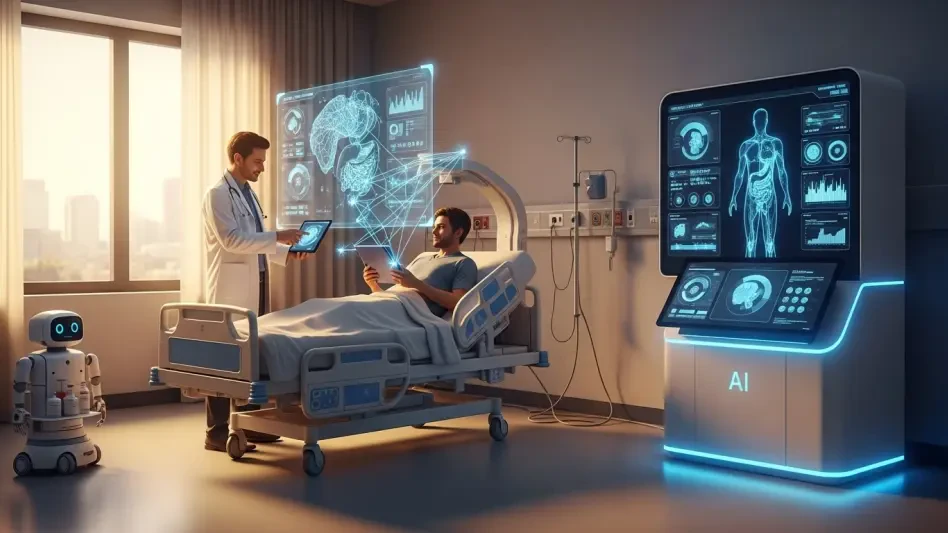The Healthcare Industry: A Landscape Ripe for AI Transformation
In an era where technological advancements shape entire sectors, healthcare stands out as a domain of both immense challenge and opportunity, with global spending on health services surpassing $8 trillion annually, making it a critical pillar of human well-being and economic stability. This industry has long been characterized by a cautious approach to adopting new technologies due to the high stakes of patient safety and regulatory oversight. Yet, the pressing need for efficiency and improved outcomes is pushing healthcare into a new frontier of innovation, particularly with artificial intelligence (AI).
The healthcare ecosystem spans diverse segments, including providers such as hospitals and clinics, payers like insurance companies, and research-driven fields of pharmaceuticals and biotechnology. Each segment faces unique pressures—providers grapple with operational bottlenecks, payers seek cost containment, and pharmaceutical companies aim to accelerate drug discovery. These distinct needs create fertile ground for AI to address specific pain points, from streamlining administrative tasks to revolutionizing medical research.
Technology adoption in healthcare is further influenced by major market players, ranging from established electronic health record (EHR) vendors to agile startups introducing cutting-edge solutions. Regulatory frameworks also play a pivotal role, setting stringent standards for data privacy and patient safety that shape the pace and scope of innovation. As a result, the industry finds itself at a crossroads, balancing the urgency for transformation with the necessity of compliance and trust.
AI Adoption in Healthcare: Unprecedented Speed and Investment
Key Trends Driving Rapid AI Integration
Healthcare’s embrace of AI is accelerating at a remarkable pace, outstripping other industries by a factor of 2.2 in adoption speed. This surge is fueled by an urgent need to tackle deep-seated operational inefficiencies, enhance patient outcomes, and optimize both clinical and administrative processes. Hospitals and clinics, under constant pressure to manage rising costs and staff shortages, are turning to AI for solutions that promise measurable impact.
Specific applications are gaining traction rapidly, including clinical documentation tools that reduce paperwork burdens for physicians, and coding and billing automation that minimizes errors in financial workflows. Patient engagement platforms and prior authorization solutions are also emerging as critical areas, empowering better communication and speeding up insurance approvals. Notably, health systems have shortened their buying cycles for AI tools by 18%, while outpatient providers have accelerated decisions by 22%, reflecting a growing urgency to implement these technologies.
In parallel, pharmaceuticals and biotechnology are leveraging AI experimentally, with 66% of companies developing proprietary models to transform drug development processes. These efforts focus on harnessing data analytics to design experiments and predict outcomes, signaling a shift toward AI-driven innovation in research. This dual focus on operational and scientific advancements underscores the breadth of AI’s influence across healthcare’s diverse landscape.
Market Insights and Growth Projections
Investment in AI within healthcare has reached unprecedented levels, with spending hitting $1.4 billion in the current year, a significant leap from previous figures. Providers dominate this financial commitment, contributing 75% of the total, or approximately $1 billion, with major allocations of $600 million toward clinical documentation and $450 million for coding and billing tools. This distribution highlights a clear priority on alleviating administrative burdens that consume valuable time and resources.
Certain AI applications are experiencing explosive growth, particularly patient engagement tools, which have expanded by a factor of 20, and prior authorization solutions, which have surged tenfold. The competitive landscape reveals a dynamic tension, as startups capture 85% of AI spending, driving innovation, while established vendors maintain trust through seamless integration with existing systems. This interplay suggests a market still finding its balance between novelty and reliability.
Looking ahead, the shift from pilot programs to full-scale production is evident, signaling a maturing market poised for sustained expansion over the coming years. As healthcare organizations move beyond experimentation, the focus turns to scalability and long-term value. Projections indicate that investments will continue to grow, particularly in areas that bridge clinical and administrative needs, shaping a future where AI is deeply embedded in daily operations.
Challenges in Scaling AI Within Healthcare
Integrating AI into healthcare’s intricate workflows presents significant hurdles, especially within the complex environments of hospitals, laboratories, and payer systems. Unlike standalone technologies, AI must mesh with existing processes, often revealing gaps between theoretical promise and practical application. This challenge is particularly acute in settings where legacy systems dominate, requiring careful customization to avoid disruption.
Industry experts, such as Derek Xiao from Menlo Ventures, point to product design and workflow alignment as the primary obstacles to scaling AI solutions. Rather than deficiencies in the technology itself, the struggle lies in crafting tools that intuitively fit into the daily routines of healthcare professionals. Misalignment can lead to resistance from users, undermining the potential benefits of even the most sophisticated AI systems.
Customer retention further complicates the landscape, with 67% of outpatient providers indicating plans to switch ambient scribe vendors within the next three years due to dissatisfaction with current offerings. Addressing these issues will require targeted strategies, such as developing specialized AI solutions tailored to specific workflows and fostering partnerships with trusted vendors who understand the nuances of healthcare delivery. Overcoming these barriers is essential to ensure sustained adoption and impact.
Regulatory and Compliance Considerations in Healthcare AI
The regulatory environment profoundly shapes AI adoption in healthcare, with stringent data privacy laws and patient safety standards dictating the boundaries of innovation. Compliance with these frameworks is non-negotiable, as breaches can erode public trust and invite severe penalties. Consequently, organizations must navigate a complex web of requirements while striving to push technological boundaries.
This regulatory caution disproportionately affects payers, who lag behind providers in AI adoption due to heightened concerns over security and accountability. Ensuring robust data protection measures and transparent AI operations is critical to building confidence among stakeholders. The balance between innovation and compliance often slows the pace of implementation, particularly for tools handling sensitive patient information.
Over the long term, adherence to regulatory standards fosters trust in AI systems, paving the way for broader acceptance. As frameworks evolve to address emerging technologies, they will likely influence the design and deployment of future solutions. Healthcare entities must remain agile, adapting to shifting guidelines while advocating for policies that support responsible innovation without stifling progress.
The Future of AI in Healthcare: Opportunities and Disruptions
Looking toward the horizon, AI in healthcare is set to evolve through domain-trained platforms like OpenEvidence, which tailor solutions to medical contexts, and practical tools such as Microsoft’s Dragon Copilot, designed to ease administrative tasks. These advancements signal a move toward more specialized applications that address specific industry needs. The trajectory suggests a deeper integration of AI into both clinical decision-making and operational efficiency.
Market disruptors, including a wave of startups and rising provider demand for seamless solutions, are poised to redefine competitive dynamics. These new entrants challenge established players by offering innovative approaches, often at lower costs, while providers push for tools that integrate effortlessly into existing systems. This tension could accelerate the pace of change, driving the industry to adapt quickly to emerging standards and expectations.
Growth areas such as personalized medicine, advanced drug discovery, and AI-driven patient care models hold immense potential to transform healthcare delivery. Influencing factors, including the speed of innovation, evolving regulatory landscapes, and global health challenges, will shape how these opportunities unfold. As the sector navigates these variables, the focus will likely remain on creating solutions that deliver both immediate value and long-term impact.
Conclusion: Healthcare’s AI Revolution and Path Forward
Reflecting on the remarkable strides made, healthcare’s adoption of AI marks a historic shift, surpassing other industries with a speed that redefines operational and clinical paradigms. The $1.4 billion investment milestone underscores a commitment to harnessing technology for transformative change, while the dual emphasis on administrative efficiency and scientific innovation highlights the sector’s multifaceted approach. Challenges in integration and retention persist, yet they serve as catalysts for refining strategies and solutions.
Moving forward, stakeholders are encouraged to prioritize workflow-aligned AI tools that seamlessly blend into daily practices, minimizing friction for end-users. Building strategic partnerships between startups and established vendors emerges as a vital step to combine innovation with reliability, ensuring broader market trust. Additionally, investing in specialized AI applications tailored to specific healthcare needs promises to address unique pain points effectively.
The journey ahead demands a balance of enthusiasm and pragmatism, with a clear focus on scalability and sustainability. By fostering collaboration across the ecosystem and advocating for adaptive regulatory frameworks, the industry positions itself to maximize AI’s potential. This path, though complex, offers a blueprint for enduring impact, setting a precedent for how technology can reshape healthcare for generations to come.









